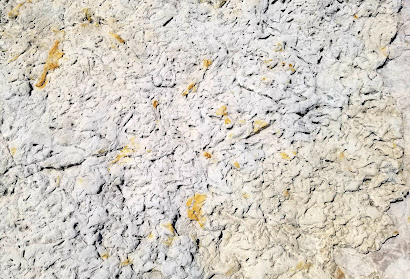Dinosaur Ridge is a Mesozoic “hogback” (a resistant ridge) in Colorado, near the town of Morrison, west of Denver. On the west side are Upper Jurassic mudstones known as the Morrison formation. Dinosaur bones and some footprints are found in the Morrison. On the east side are younger Cretaceous sandstones, the Dakota formation. Most of the dinosaur footprints, trace fossils and ripple marks are seen in the Dakota. Cross section below from the James St. John website.
This is a road-cut at the top of the hogback showing the Cretaceous/ Jurassic boundary. Note the globular concretion in the Morrison.
This therapod track was found in a boulder and moved to its
current location. It maybe from a young Allosaurus. Therapods were three-toed carnivores and are
the distant ancestors of modern birds; in fact, some had feather-like skin covering.
This bulge is probably a sauropod foot print (possibly an Apatosaurus), seen in cross-section. Sauropods had very long necks, long tails, small heads and four thick, pillar-like legs.
The Apatosaurus is a typical sauropod, much like the famous brontosaurus.
A rare velociraptor (commonly shortened to "raptor") footprint. They were related to the related to the therapods. This is one of only twelve raptor sites in the world.
Bones of a sauropod dinosaur, possibly an Atlantosaurus (similar to the
Iguanodontid and theropod dinosaur tracks; stained gray with charcoal for easier visibility. Iguanodontids were large herbivores which were both bipedal and quadrupedal.
Crocodilian claw scratch marks
Ripple-marks made in shallow water.
Invertebrate trace fossils: burrows made by invertebrates in the soft shoreline mud.












No comments:
Post a Comment